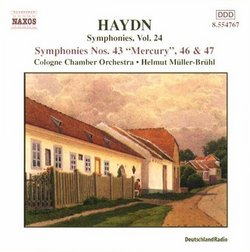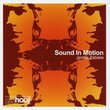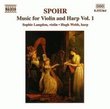| All Artists: Helmut Müller-Brühl, Helmut Muller-Bruhl Title: Haydn: Symphonies, Vol. 24--Nos. 43, 46, & 47 Members Wishing: 0 Total Copies: 0 Label: Naxos Release Date: 7/17/2001 Genre: Classical Styles: Historical Periods, Classical (c.1770-1830), Symphonies Number of Discs: 1 SwapaCD Credits: 1 UPC: 636943476727 |
Search - Helmut Müller-Brühl, Helmut Muller-Bruhl :: Haydn: Symphonies, Vol. 24--Nos. 43, 46, & 47
 | Helmut Müller-Brühl, Helmut Muller-Bruhl Haydn: Symphonies, Vol. 24--Nos. 43, 46, & 47 Genre: Classical
|
Larger Image |
CD DetailsSimilar CDs
|
CD ReviewsDiscovering the Haydn Symphonies on Naxos Robin Friedman | Washington, D.C. United States | 01/21/2004 (5 out of 5 stars) "Franz Joseph Haydn (1732-1809)wrote 104 symphonies, most of which were composed at Esterhaza, where Haydn served as Kappelmeister to a wealthy nobleman. There is a tendency to underestimate Haydn's achievement, perhaps because he wrote so prolifically. But Haydn's symphonic output, not merely the "London" or the "Paris" symphonies, is a treasure with much to reward the listener willing to explore. Haydn is lyrical, humorous, and endlessly inventive. The budget-priced Naxos label has been issuing a complete set of his symphonies performed by several different chamber orchestras and conductors over the years, and they provide an endless source of discovery. I much prefer buying these recordings one at a time rather than in a complete set because it allows me to spend time with each individual work.Anyway, why symphonies 43, 46, and 47? I was drawn to explore Haydn's symphony no. 46 in B-major by comments of Lewis Lockwood in his recent book: Beethoven: the Music and the Life. (2003) Lockwood searches for possible antecedents to Beethoven's integration of the Scherzo and Finale in his Fifth Symphony. He points to Haydn's 46th symphony (as well as to the 45th) as a possible source (see page 220). In the 46th symphony, written in 1772, Haydn writes a brisk final movement in which the theme is succeeded by many stops and then followed each time by new thematic material. After the last such stop, Haydn reprises a theme from the minuet movement of the symphony. The effect is, on the whole, humorous and lively, not at all like Beethoven's fifth. But Haydn's composition is striking and shows his creative power in a work that is not often played.The 46th symphony is full of contrasts between major and minor modes and is, until the finale, a rather subdued somber work. There is a great deal of writing in the minor in each of the exposition, development, and recaptitulation of the opening movement; and the second movement, marked "poco adagio" is poignant and dark-hued with writing for the solo violin and cello. The third movement minuet is surprisingly restrained, but the final, with its reprise of the minuet, brings some jollity to the work. It is altogether an excellent symphony.The disc opens with Haydn's symphony number 43 in E-flat major, known as the "Mercury" composed in 1770. I think the nickname refers to the flighty, light character of the work although the program notes offer a different possible explanation. The work opens with a single loud chord followed by extended melodic material. There is a great deal of upward scale passages in the violin, a possible source of the nickname. The second movement, adagio, is written for string orchestra and it features an opening, halting, theme juxtaposed against a long legato melody. The minuet is almost march-like in tone while the finale, marked allegro, again features a short opening phrase balanced against an expansive second theme. This is a lively, accessible work.The disc concludes with the symphony no. 47 in G major. The program notes to this music show the great musical inventiveness behind the surface simplicity of this work. The second movement, a theme with variations, and the third movement minuet of this symphony both feature skilled use of counterpoint in which a single theme is turned around on itself to form its mirror image. The opening movement has an opening theme in which the horns play a leading role followed by a flowing theme for violins and oboe. The finale centers again on its opening theme (bringing a stylistic unity to the work) with some concertante writing for solo instruments at the end.The performance here is by the Cologne Chamber Orchestra conducted by Helmut Muller-Bruhl. The program notes are helpful in approaching the music. This disc, and the many related discs on Naxos, will show the listener how much wonderful music remains to be discovered in the symphonies of Haydn." Great Music, Not Just A Way To Fill-In Your Haydn Collection Michael B. Richman | Portland, Maine USA | 07/04/2003 (4 out of 5 stars) "When I first got into classical music, purchasing all 104 symphonies by Haydn seemed like a monumental, if not impossible task. I simply couldn't afford something as grand as the Dorati Complete Haydn Symphonies Box Set (though one of these days it will be mine!). With so many choices available for the "Paris" Symphonies up through the "London" Symphonies, I have had a great time purchasing and comparing interpretations by various conductors - Bernstein, Szell, Davis, Beecham, Jochum, Furtwangler, Klemperer, Kempe, Karajan and Ansermet among others. However, if you are looking for Haydn pre-Symphony No. 82, your choices diminish drastically.
While I have generally steered away from Naxos when it comes to the standard repertoire (I just enjoy the "great" conductors and performers of the century too much), the label has never let me down when trying to get recordings of more obscure works. I am now the proud owner of nearly a dozen Haydn Naxos Symphony CDs, including this title, Volume 24 of Symphonies 43, 46 and 47 with Bruhl and the Cologne C.O. While they are different symphonies from the "great" conductor accounts I mentioned above, in terms of overall quality and sound, the performances are completely on par, well at least to my intermediate-level listening ear. At this rate, I may continue backwards with Haydn's Symphonies on Naxos until I reach el numero uno. And another nice thing is that with Naxos that might even be an affordable undertaking." |

 Track Listings (12) - Disc #1
Track Listings (12) - Disc #1



